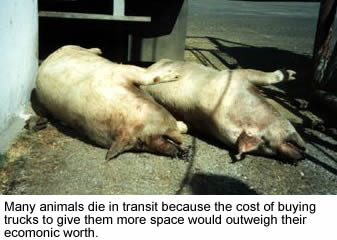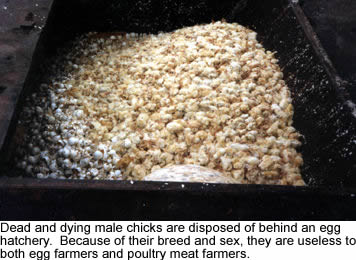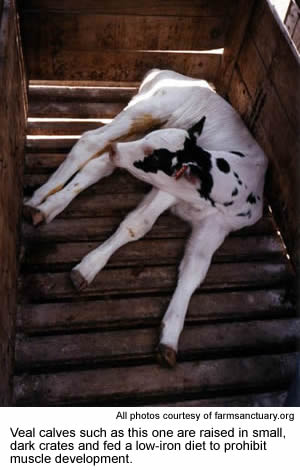
Inside April 22, 2003's Issue
-Features-
‘Factory Farming’ economically viable, environmentally unconscious
By Chris Hammonds
Assistant Editor
Paul McCartney once said that if all slaughterhouses had
glass walls, the whole world would be vegetarian. Everyone knows where
their food comes from, but many people aren’t aware of the process
most livestock goes through on the journey from birth to the dinner plates.
 The family-owned farms of yesteryear have become almost irrelevant. Global
economics have given rise to the factory farm, an institution where animals
are bred, slaughtered and packaged in a mass-production environment. The
processes involved in factory-farm production are largely automated. This
has led to widespread concern regarding animal treatment and environmental
well-being.
The family-owned farms of yesteryear have become almost irrelevant. Global
economics have given rise to the factory farm, an institution where animals
are bred, slaughtered and packaged in a mass-production environment. The
processes involved in factory-farm production are largely automated. This
has led to widespread concern regarding animal treatment and environmental
well-being.
Sow pigs nurse their piglets for around three weeks before being re-impregnated.
The piglets are then old enough to be separated into their own small metal
crates, where they are subjected to a diet of chemicals and antibiotics.
Because of the psychological trauma suffered by the pigs (who have roughly
the intellect of dogs), they routinely undergo processes in which their
tails are removed and their teeth are snipped so that they cannot harm
themselves by nervous biting.
Antibiotics are withdrawn around the last week of the pig’s six-month
life. Because they have been fed a steady diet of chemicals since their
birth, the loss of the antibiotics often causes them to contract pneumonia,
which results in violent shaking and loss of bowel control. They then
make the journey to the slaughterhouse, often seeing the sun for the first,
and last time of their lives. The pigs are then electrocuted, stabbed
in the jugular and tied so that they can be dunked in scalding water to
remove hair. The workers often wear earplugs to muffle the screaming of
the dying pigs.
 Both
boiler chickens and egg-laying hens often have the tips of their beaks
and toes snipped very early in their life in an effort to minimize the
damage they can do to each other and their eggs while confined to small
spaces. They are also typically kept in the dark to prevent fighting.
Both
boiler chickens and egg-laying hens often have the tips of their beaks
and toes snipped very early in their life in an effort to minimize the
damage they can do to each other and their eggs while confined to small
spaces. They are also typically kept in the dark to prevent fighting.
Lighting schedules are used to maintain the illusion of an eternal spring—a
practice intended to maximize egg production in factory hens. According
to a www.factoryfarming.com
report, egg-laying chicken breeds are selected for maximum egg production
and do not grow fast enough or large enough to be raised for meat. Therefore,
male chicks are of no economic value and are typically disposed of upon
birth. Common methods for disposing of the newly hatched chicks are grinding
them up alive or piling them in trash-bins to suffocate.
 Veal calves are separated from their mothers almost directly after birth
and confined to small crates where there is rarely even enough space to
turn around or stand up. They are fed a low-iron diet to prohibit muscle
development so that their flesh is light colored and tender, which is
a consumer preference when purchasing veal. Antibiotics are also injected
into veal calves to keep them alive and enhance their growth rate. The
average life span of a veal calf is around four months.
Veal calves are separated from their mothers almost directly after birth
and confined to small crates where there is rarely even enough space to
turn around or stand up. They are fed a low-iron diet to prohibit muscle
development so that their flesh is light colored and tender, which is
a consumer preference when purchasing veal. Antibiotics are also injected
into veal calves to keep them alive and enhance their growth rate. The
average life span of a veal calf is around four months.
The milk produced for the calves during the mother cow’s lactation
is used for dairy products. Dairy cows are given hormones to increase
milk production. Many of these hormones cause health ailments such as
calcium defeciency and birth defects.
Male cows are routinely castrated and de-horned without anesthesia.
Because of the use of antibiotics on factory-farmed animals, it comes
as no surprise that millions of Americans are infected every year by contaminated
animal products.
The pathogens infecting the animal products become virulent because the
antibiotics and hormones used to maximize factory farm production allow
viruses to grow resistant or immune to the current treatments.
According to the Center for Disease Control, an estimated 76 million Americans
(around one-third) get sick and 5,000 die annually from food-borne illnesses,
which are often caused by aberrant farming practices.
According to a 2001 Sierra Club report, compiled from USDA factsheets,
Excel Corporation, America’s third-largest meat-packing enterprise,
recalled approximately 190,000 pounds of fresh ground beef and pork in
June 2001 from southern states (including Alabama, Georgia, Kentucky,
South Carolina and Tennessee) when the USDA’s Food Safety and Inspection
Service’s samples of the meat tested positive for E. Coli bacteria.
According to reports from the Sierra Club, the quantity of waste produced
by livestock is more than 130 times greater than that of humans. Agricultural
runoff, including waste, kills millions of fish and is a primary cause
for the pollution of rivers and streams.
Around 70 percent of the grain produced in the United States is used to
feed livestock. It is estimated that if Americans reduced their meat consumption
by 10 percent it would free 12,000,000 tons of grain— enough to
feed 60 million people.
| Front Page | News | Features | Editorials | Opinions | Entertainment | Sports |
| Honors
| Graduates |
Archives | Our Staff | Application
| History | F.A.Q.'s
|
![]()
Copyrighted © 1999-2001 Six Mile Post
All Rights Reserved
